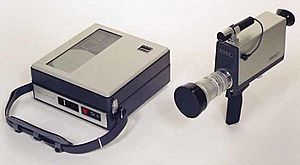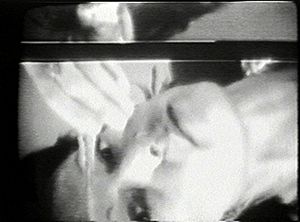Video art facts for kids
Video art is a type of art that uses video technology. It uses video as a way to show images and sounds. Video art started in the late 1960s. This was when new video tools, like video tape recorders, became available to everyone. Before that, only big companies had them.
Video art can be shown in many ways. It can be recordings that are shown on TV. It can be installations you see in art galleries or museums. Some works are streamed online. Others are shared on video tapes or DVDs. It can also be performances that use television sets, video monitors, or projections. These show live or recorded pictures and sounds.
Video art got its name from the old video tapes. These tapes were the main way to record video art until the 1990s. Later, digital recording tools came out. Many artists then started using digital technology to create new kinds of art.
Video art is different from regular movies. It doesn't always use actors or have talking. It might not have a clear story or plot. It doesn't follow the usual rules for movies made for entertainment. This makes video art different from other film types. These include avant-garde films, short films, or experimental films.
Contents
How Video Art Started
Nam June Paik, an artist from Korea and America, is known as a pioneer in video art. He studied in Germany. In March 1963, Paik showed his "Exposition of Music – Electronic Television" in Wuppertal. In May 1963, Wolf Vostell showed his "6 TV Dé-coll/age" in New York. Vostell also made a video called "Sun in your head" in Cologne. This video was first made on film and then put on videotape in 1967.
Many say video art truly began in 1965. Paik used his new Sony Portapak camera. He filmed Pope Paul VI's parade in New York City. Later that day, Paik played the tapes in a cafe. That moment is often called the birth of video art.
Before consumer video cameras, making moving pictures was hard. You could only use 8mm film or 16mm film. After the Portapak came out, many artists began to explore this new technology.
Many early video artists were also involved in other art movements. These included conceptual art, performance art, and experimental film. Some famous early video artists were Vito Acconci, Valie Export, John Baldessari, Peter Campus, Joan Jonas, Bruce Nauman, Nam June Paik, and Bill Viola. Others, like Steina and Woody Vasulka, used video synthesizers. They made abstract works with interesting video effects. In Canada, Kate Craig, Vera Frenkel, and Michael Snow helped video art grow.
Video Art in the 1970s
Much of the video art in the 1970s explored the limits of video. For example, Peter Campus created "Double Vision." He mixed video signals from two Sony Portapaks. This made a strange and distorted image. Another example is Joan Jonas's "Vertical Roll." She recorded herself dancing. Then she played the videos back on a TV. This created a complex, layered image.
Many video artists in the United States worked in New York City. The Kitchen was founded in 1972 by Steina and Woody Vasulka. It became a hub for many young artists. An early multi-channel video art piece was "Wipe Cycle." It was made by Ira Schneider and Frank Gillette. "Wipe Cycle" was shown in 1969. It used nine TV screens. It showed live images of visitors, TV clips, and pre-recorded tapes. The images moved from one screen to another in a planned way.
On the West Coast, Willoughby Sharp started "Videoviews" in 1970. These were video-taped talks with artists. Sharp talked with artists like Bruce Nauman and Joseph Beuys. In 1970, Sharp also organized "Body Works." This show featured video art by Vito Acconci and William Wegman. It was shown in San Francisco.
In Europe, Valie Export created "Facing a Family" (1971). This was one of the first video art pieces shown on TV. It was broadcast in Austria in 1971. The video showed a family watching TV while eating dinner. This made the audience see themselves in the art. Export believed TV could change how people saw art. In the UK, David Hall's "TV Interruptions" (1971) were shown on Scottish TV. These were the first art pieces broadcast on British television without warning.
Video Art in the 1980s and 1990s
As video editing software became cheaper, more people could use it. This changed how artists worked with video. At the same time, new TV channels appeared in Europe. Music videos also became popular. Artists like Gary Hill and Bill Viola used special effects and high-quality images.

Festivals for video art also grew. These included the World Wide Video Festival in The Hague and Ars Electronica in Linz. These festivals showed how important video art was becoming.
By the early 1990s, major art shows started including video art. The Venice Biennale and the Louisiana Museum featured video works. Art galleries also showed videos by a new generation of artists. These artists used lighter cameras like Handycams. This allowed them to film more easily outside their studios. Artists like Pipilotti Rist, Tony Oursler, and Carsten Höller filmed by hand. They sometimes mixed their own footage with found images.
Showing video art also became simpler. Monitors were placed in exhibition rooms. Videos were distributed on VHS tapes. This new generation of artists explored themes like feminism and gender. They also mixed different media. They used old film, digital editing, and sounds from many sources.
Museums specializing in video art also embraced digital technology. The ZKM in Karlsruhe, led by Peter Weibel, held many video art shows. The Centre pour l'Image Contemporaine also had its biennial "Version" (1994-2004).
With the rise of digital technology and the Internet, some museums shared their video art collections online. For example, http://www.newmedia-art.org/ was created by the Centre Georges Pompidou in Paris and the Museum Ludwig in Cologne.
By the end of the century, artists and institutions explored new digital tools. These included 3D images, interactive art, and the Internet. New themes like interactivity and non-linear stories appeared. Some artists combined physical and digital methods. An example is Jeffrey Shaw's "Legible City" (1988–91). Others used simple online interactivity, like Claude Closky's "+1" in 1996. However, these works started to move towards New media art and Internet art.
Video Art After 2000
As video footage and editing tools improved, some artists made complex story videos. They did this without filming any of their own footage. Marco Brambilla's "Civilization" (2008) is a "video mural." It uses many clips to show heaven and hell. Johan Grimonprez's Dial H-I-S-T-O-R-Y is a 68-minute film. It interprets the Cold War and the role of terrorists. It uses almost only original TV and film clips.
In the 2000s, video art became very common in international art shows. It was normal to see artist videos in group shows. They were displayed on monitors or as projections. More than a third of the works at Art Unlimited (a section of Art Basel) were video installations between 2000 and 2015. Many art biennials also showed video art. A new generation of artists emerged. These included Pipilotti Rist, Francis Alys, and Matthew Barney. They were shown alongside older artists like Bill Viola and Joan Jonas.
Some artists also reached wider audiences by making movies. Apichatpong Weerasethakul won the 2010 Cannes Film Festival "Palm d'or." Others curated big public events, like Pipilotti Rist's Swiss National Expo02.
In 2003, Kalup Linzy created "Conversations Wit De Churen II: All My Churen." This was a funny soap opera. It helped create a new type of video and performance art. Linzy's work is unique and has greatly contributed to video art. Ryan Trecartin, a young experimental video artist, uses bright colors and unusual editing. He also uses strange acting to show what The New Yorker calls "a cultural watershed."
Performance Art and Video Art
Video art can also be combined with other art forms. One example is Performance art. This mix is sometimes called "media and performance art." Artists "break the mold of video and film" to expand art's boundaries. As artists got more video cameras, performances could be recorded. This allowed them to be shared with many people.
Artists like Marina Abramovic and Ulay filmed their performances in the 1970s and 1980s. In their piece "Rest Energy" (1980), Ulay held an arrow aimed at Marina's heart. Marina held the bow. They both leaned back, keeping tension on the bow. The piece lasted 4 minutes and 10 seconds. Marina said it was "a performance about complete and total trust."
Other artists used the camera as the audience. Kate Gilmore experimented with where she placed the camera. In her video "Anything" (2006), she tries to reach the camera. The camera is looking down at her. For 13 minutes, she ties furniture together while trying to get to the camera. Gilmore often adds struggle to her art. In her video "My love is an anchor" (2004), she lets her foot dry in cement. Then she tries to break free on camera. Gilmore has said she was inspired by artists like Marina Abramovic. She adds extreme effort and struggle to her work.
Some artists explored space when mixing video and performance art. Ragnar Kjartannson, an Icelandic artist, filmed a music video. Nine different artists, including himself, were filmed in different rooms. They could hear each other through headphones. This allowed them to play the song together. The piece was called "The Visitors" (2012).
Artists like Jaki Irvine and Victoria Fu have mixed 16 mm film, 8 mm film, and video. They use the way images, music, and narration can be disconnected. This helps them break away from a simple, linear story.
Studying Video Art in Schools
Since 2000, colleges and universities have started offering video arts programs. These are often part of film or broadcast studies. Programs like those at Northeastern and Syracuse teach basic skills. These include lighting, editing, and camera work. These skills can help with film or TV production. With the growth of entertainment media, skills like animation and motion graphics are also taught. These are higher-level courses in this growing field.
Important Video Art Places
- Ars Electronica Center (AEC), Linz, Austria
- Edith-Russ-Haus for Media Art, Oldenburg, Germany
- Electronic Arts Intermix, New York, NY
- Experimental Television Center, New York
- Goetz Collection, Munich, Germany
- Imai – inter media art institute, Düsseldorf
- Impakt Festival, Utrecht
- Julia Stoschek Collection, Düsseldorf, Germany
- Kunstmuseum Bonn, has a large video art collection
- LA Freewaves is a festival for experimental media art. It shows video art, short films, and animation. Exhibitions are in Los Angeles and online.
- Lumen Eclipse – Harvard Square, MA
- LUX, London, UK
- London Video Arts, London, UK
- Neuer Berliner Kunstverein with its "Video-Forum" started in 1971 – Berlin, Germany
- Perpetual art machine, New York
- Raindance Foundation, New York
- Souvenirs from Earth, Art TV Station on European Cable Networks (Paris, Cologne)
- Vtape, Toronto, Canada
- Videoart at Midnight, an artists' cinema project, Berlin, Germany
- Video Data Bank, Chicago, IL.
- VIVO Media Arts Centre, Vancouver, Canada
- ZKM Center for Art and Media Karlsruhe, Germany
- Videobrasil, Associação Cultural Videobrasil, São Paulo, Brazil
See also
 In Spanish: Videoarte para niños
In Spanish: Videoarte para niños
- Artmedia
- Experimental film
- INFERMENTAL
- Interactive film
- List of video artists
- Music video
- Music visualization
- New media art
- Optical feedback
- Real-time computer graphics
- Scratch video
- Single-channel video
- Sound art
- Video jockey
- Video poetry
- Video sculpture
- Video installation
- Video synthesizer
- Visual music
- VJ (video performance artist)



